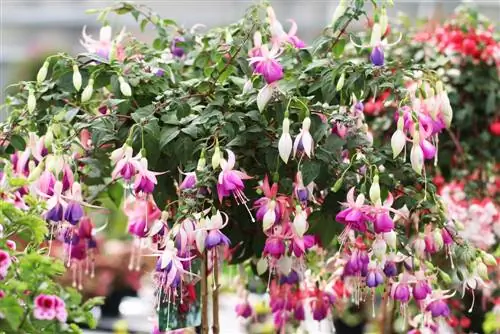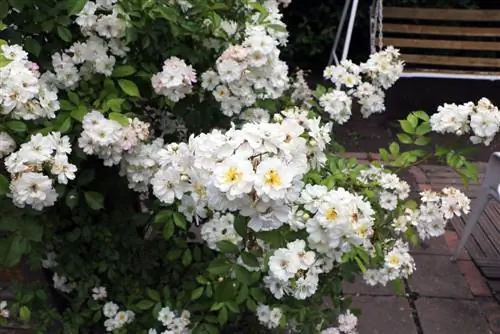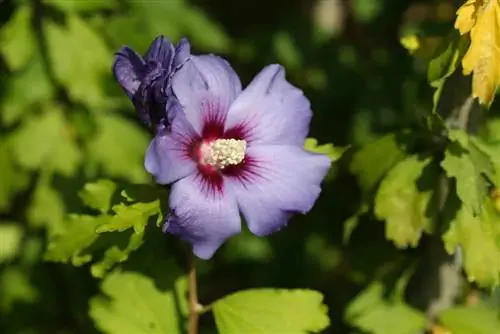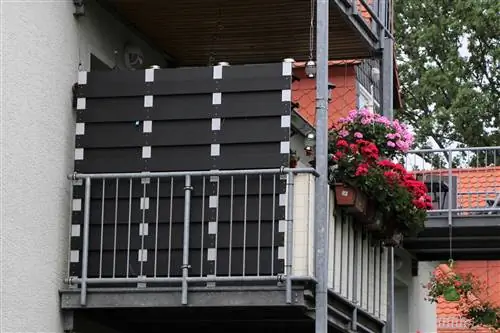- Author admin [email protected].
- Public 2023-12-17 03:39.
- Last modified 2025-06-01 06:48.
Climbing plants are roughly divided into self-climbers and scaffold-climbing plants. The self-climbers include ivy, trumpet morning glories and climbing hydrangeas. Scaffold climbing plants include climbing plants such as clematis or vines, climbing plants such as honeysuckle or spreading climbers such as blackberries or climbing roses.
Annual climbing plants
Asarina - Gloxinia Morning Glory
- reaches a height of 2 - 3 m
- grows very well in pots
- - mostly sunny, the plant can tolerate partial shade
- - plant in February
- plant outdoors after the Ice Saints
Cardiospermum halicacabum - balloon wine, heart seeds:
- 4 - 5 cm large fruits
- reaches a height of up to 3 m
- Climbing plant for balconies, terraces or fences
- is also suitable as a pot plant
- Location must be sunny, warm and protected
- Plant at the end of February / beginning of March
- Plant outdoors from 22 degrees
Cobaea scandens - bell vine, claw vine
- become 3 to 4 m high
- need climbing aids e.g. B. Bars
- Terrace, balcony, on walls and fences
- sunny, warm
- Part shade causes smaller flowers
- Plant in a warm place at the end of February/beginning of March
- plant outdoors after the Ice Saints
Cucurbita pepo - ornamental pumpkin
- up to 5 m high
- about 20 cm large flowers and fruits
- as a privacy screen, for green walls
- very fond of warmth
- sunny location
- fertilize and water
- outdoors from mid-May
Ipomoea tricolor - morning glory
- Privacy protection for balconies and terraces, fences
- up to 3 m.
- sunny and sheltered from the wind
- nutrient-rich, calcareous, sandy loamy soil
- sow in pots from March to April
- slowly get used to cold temperatures
Lathyrus odoratus - sweet pea
- Fences, garden, terrace or balcony
- 20 to 80 cm high
- sunny, sheltered from the wind
- loose, nutrient-rich soil
- water regularly
- sow directly outdoors from the end of March to mid-April
Phaseolus coccineus - runner bean, runner bean
- Visibility and wind protection for terraces and balconies
- 3 - 4 m tall growth
- need trellis and climbing aids
- sunny to partially shaded
- water a lot on dry and warm days
- sow directly outdoors from mid-May
- cover overnight and protect from frost
Ipomea quamoclit - star winds
- up to 5 m high
- as privacy screen, on fences, walls
- warm and sunny location
- loose, humus-rich soil
- sow from mid-February to mid-March
- plant outdoors from the end of May
Rhodochiton atrosanguineus - rose calyx, rose mantle
- will be more than 3 m high
- requires grid-like climbing aids
- as a pot plant for terraces and balconies
- Can also be used as a hanging plant
- in full sun, warm and protected
- watering and fertilizing regularly
- starts about 5 months after sowing
- Sowing from the end of January to the end of February
- Germination temperature 15 to 20 °C
- plant outdoors from the end of May

Thunbergia alata - Black-eyed Susanne
- becomes 1.5 to 2 m high
- heart-shaped leaves
- Garden, balcony and terrace as a hanging plant
- needs a climbing aid
- sunny, warm and sheltered from the wind
- loose and humus-rich soil
- Sowing from the beginning of March
- plant outdoors from the end of May
Tropaeolum - Nasturtium
- rounded, shield- to kidney-shaped leaves
- dense, lush green foliage
- edible leaves and flowers (hot, mustard or cress-like taste)
- 30 cm to 3 m high
- grow on fences and need climbing aids
- robust and undemanding plant
- Sun and partial shade
- direct sowing outdoors is from the beginning of May
- plant outdoors from the end of May
Perennial climbing plants
Trumpet Flower
- large-scale greening of walls
- also for arbors, arches and pergolas
- need climbing aid e.g. B. Climbing grid
- protected location with lots of warmth and sun
- protect from excessive sunlight
- Location like in a sparse forest
- cut back last year's shoots by 3 to 4 eyes in March
Clematis
- 2 - 5 m high
- for large and small arbors, pergolas, fences and walls
- sunny to partially shaded
- nutrient-rich and permeable soil
- water regularly and avoid waterlogging
- Protect the root area with small bushes
- distinguish between spring and summer bloomers
- Spring flowering plants should be shortened slightly after flowering
- Cut back summer bloomers heavily in February/March
Climbing hydrangea
- slow growth
- up to 12 m high
- 10 cm large, heart-shaped leaves
- on house walls with climbing aids, e.g. B. Wire ropes
- protect from cold drafts
- Part shade to shade
- high water requirement
- Cutting not required
- cut dead branches or disturbing shoots
Winter Jasmine
- 2 to 3 m high
- Growth width 2 m
- on walls and other climbing aids
- protected location
- light partial shade
- sunny, warm
- nutrient-rich, permeable soil
- light spring pruning every 2 to 3 years
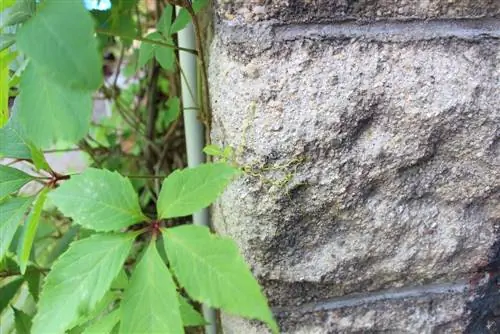
Wild Wine
- 10 to 15 m high
- vertical, little coverage
- Greening of large areas
- as privacy and sun protection on pergolas, arbors and fences
- in large plant containers
- robust and easy to care for
- Sun to partial shade
- let it grow wild
- no cutting necessary
climbing rose
- on arches, trellises or fences, arbors and pergolas
- 1, 5 m up to 5 m high
- originally on the edge of the forest
- Sun to light partial shade
- South and west side
- nutrient-rich soil, water regularly
- needs sufficient winter protection e.g. B. thin fleece
- prune every 1 to 2 years after the strongest frost
- only cut back 2 to 3 eyes
Climbing plants can be used in a variety of ways as annual or perennial plants to beautify the garden. They are particularly suitable for greening walls and as privacy and light protection. The majority of the plants are easy to care for and prefer full sun, so the right location shouldn't be difficult to find. With proper care, the magnificent flowers will decorate walls, walls and arbors. You should water regularly, but make sure that no waterlogging occurs.
Quick overview
Climbing plants are available as annual and perennial plants. Annual climbing and climbing plants are popular because of their long-lasting blooms. They are often kept as container plants.
- Annual climbing plants: bell vine, fairy vine, morning glory, sweet pea, morning glories, passion flower, runner bean, black-eyed Susan and nasturtium.
- Perennial climbing plants: kiwi, akebia, pipe bindweed, climbing trumpets, tree shrikes, clematis, ivy, climbing hydrangeas, winter jasmine, honeysuckle, wall vine, wild vines, knotweed, firethorn, wisteria and climbing roses.
According to the development of their climbing organs, climbing plants are divided into four groups: creepers, tendril climbers, spreading climbers and self-climbers. A distinction is made between self-climbing plants such as ivy, which attaches itself directly to the growth base with small roots from the shoot, and scaffold-climbing plants such as real vines, which require a climbing aid in order to be able to spread. The scaffold climbing plants include the tendrils, the winders or creepers and the spreading climbers. Vines, such as the clematis, climb with petioles or sprouts formed into tendrils. Winders or twiners like hops wind their entire shoot upwards. Spreader climbers climb with the help of long, thin shoots that bend under their own weight, which they place on climbing aids.
Climbing plants are suitable for both sunny and shady locations. As a rule, climbing and climbing plants are grown in containers or pots. Many climbing plants such as ivy are evergreen. You can choose between different leaf sizes and colors and can also add additional splashes of color through flowering climbing plants.



